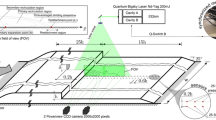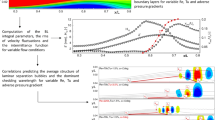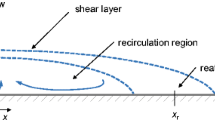Abstract
The effect of the Reynolds number on the mechanism of the formation of an instantaneous local flow separation that occurs in the near-wall region of a turbulent boundary layer is experimentally studied. The features of application of the high-speed planar PIV method with a high spatiotemporal resolution are discussed. Comparison of the measurement results obtained within a viscous sublayer of a turbulent boundary layer with the results of other studies showed the generality of the mechanism for the formation of an instantaneous local flow separation in the range of dynamic Reynolds number 207 ≤ Reτ ≤ 672.
Similar content being viewed by others
References
H. Eckelmann, The structure of the viscous sublayer and the adjacent wall region in a turbulent channel flow, J. Fluid Mech., 1974, Vol. 65, No. 3, P. 439–459.
K.J. Colella and W.L. Keith, Measurements and scaling of wall shear stress fluctuations, Exp. Fluids, 2003, Vol. 34, No. 2, P. 253–260.
Z. Hu, C.L. Morfey, and N.D. Sandham, Wall pressure and shear stress spectra from direct simulations of channel flow, AIAA J., 2006, Vol. 44, No. 7, P. 1541–1549.
P. Lenaers, Q. Li, G. Brethouwer, P. Schlatter, and R. Örlü, Rare backflow and extreme wall-normal velocity fluctuations in near-wall turbulence, Phys. Fluids, 2012, Vol. 24, No. 3, P. 035110–1–035110–19.
R.C. Chin, J.P. Monty, M.S. Chong, and I. Marusic, Conditionally averaged flow topology about a critical point pair in the skin friction field of pipe flows using direct numerical simulations, Phys. Rev. Fluids, 2018, Vol. 3, No. 11, P. 114607–1–114607–13.
M. Bross, T. Fuchs, and C.J. Kähler, Interaction of coherent flow structures in adverse pressure gradient turbulent boundary layers, J. Fluid Mech., 2019, Vol. 873, P. 287–321.
C.E. Willert, C. Cuvier, J.M. Foucaut, J. Klinner, M. Stanislas, J.P. Laval, S. Srinath, J. Soria, O. Amili, C. Atkinson, C.J. Kähler, S. Scharnowski, R. Hain, A. Schröder, R. Geisler, J. Agocs, and A. Röse, Experimental evidence of near-wall reverse flow events in a zero pressure gradient turbulent boundary layer, Exp. Therm. Fluid Sci., 2018, Vol. 91, P. 320–328.
B. Guerrero, M.F. Lambert, and R.C. Chin, Extreme wall shear stress events in turbulent pipe flows: spatial characteristics of coherent motions, J. Fluid Mech., 2020, Vol. 904, P. A18–1–A18–39.
D. Zaripov, V. Ivashchenko, R. Mullyadzhanov, R. Li, N. Mikheev, and C.J. Kähler, On a mechanism of near-wall reverse flow formation in a turbulent duct flow, J. Fluid Mech., 2021, Vol. 923, P. A20–1–A20–12.
D. Zaripov, V. Ivashchenko, R. Mullyadzhanov, R. Li, D. Markovich, and C.J. Kähler, Reverse flow phenomenon in duct corners at a low Reynolds number, Phys. Fluids, 2021, Vol. 33, No. 8, P. 085130–1–085130–11.
D.I. Zaripov, Problems of an experimental study of a reverse flow in the turbulent channel flow, J. Phys. Conf. Ser., 2021, Vol. 2057, No. 1, P. 012097–1–012097–5.
M.S. Chong, J.P. Monty, C. Chin, and I. Marusic, The topology of skin friction and surface vorticity fields in wall-bounded flows, J. Turbul., 2012, Vol. 13, No. 13, P. N6–1–N6–10.
J.I. Cardesa, J.P. Monty, J. Soria, and M.S. Chong, The structure and dynamics of backflow in turbulent channels, J. Fluid Mech., 2019, Vol. 880, P. R3–1–R3–11.
C. Brücker, Evidence of rare backflow and skin-friction critical points in near-wall turbulence using micropillar imaging, Phys. Fluids, 2015, Vol. 27, No. 3, P. 031705–1–031705–7.
R. Vinuesa, R. Örlü, and P. Schlatter, Characterization of backflow events over a wing section, J. Turbul., 2017, Vol. 18, No. 2, P. 170–185.
C. Diaz-Daniel, S. Laizet, and J.C. Vassilicos, Wall shear stress fluctuations: Mixed scaling and their effects on velocity fluctuations in a turbulent boundary layer, Phys. Fluids, 2017, Vol. 29, No. 5, P. 055102–1–055102–14.
Y.C. Yao, W.X. Huang, and C.X. Xu, Amplitude modulation and extreme events in turbulent channel flow, Acta Mech. Sin., 2018, Vol. 34, No. 1, P. 1–9.
R. Jalalabadi and H.J. Sung, Influence of backflow on skin friction in turbulent pipe flow, Phys. Fluids, 2018, Vol. 30, No. 6, P. 065104–1–065104–9.
C. Pan and Y. Kwon, Extremely high wall-shear stress events in a turbulent boundary layer, J. Phys. Conf. Ser., 2018, Vol. 1001, No. 1, P. 012004–1–012004–13.
J.I. Cardesa, J.P. Monty, J. Soria, and M.S. Chong, Skin-friction critical points in wall-bounded flows, J. Phys. Conf. Ser., 2014, Vol. 506, No. 1, P. 012009–1–012009–15.
D. Zaripov, R. Li, and N. Dushin, Dissipation rate estimation in the turbulent boundary layer using high-speed planar particle image velocimetry, Exp. Fluids, 2019, Vol. 60, No. 1, P. 18–1–18–16.
M.P. Tokarev, D.M. Markovich, and A.V. Bilsky, Adaptive algorithms for PIV image processing, Computation Technologies, 2007, Vol. 12, No. 3, P. 109–131.
J.M. Wallace, Quadrant analysis in turbulence research: history and evolution, Annu. Rev. Fluid Mech., 2016, Vol. 48, No. 1, P. 131–158.
S.K. Robinson, The kinematics of turbulent boundary layer structure, NASA Tech. Memo, 1991, No. 103859, P. 479.
A.V. Boiko, G.R. Grek, A.V. Dovgal, and V.V. Kozlov, Formation of Turbulence in the Near-Wall Flows, Nauka, Novosibirsk, 1999.
C.R. Smith, J.D.A. Walker, A.H. Haidari, and U. Sobrun, On the dynamics of near-wall turbulence, Philos. Trans. R. Soc., London, Ser. A Phys. Eng. Sci., 1991, Vol. 336, No. 1641, P. 131–175.
R.J. Adrian, C.D. Meinhart, and C.D. Tomkins, Vortex organization in the outer region of the turbulent boundary layer, J. Fluid Mech., 2000, Vol. 422, P. 1–54.
Author information
Authors and Affiliations
Corresponding author
Additional information
The study was supported by the grant of the Russian Science Foundation No. 22-29-01274.
Rights and permissions
About this article
Cite this article
Zaripov, D.I., Lukyanov, A.A. & Markovich, D.M. Experimental investigation of instantaneous local flow separation in a turbulent boundary layer at various Reynolds numbers. Thermophys. Aeromech. 29, 647–652 (2022). https://doi.org/10.1134/S086986432205002X
Received:
Revised:
Accepted:
Published:
Issue Date:
DOI: https://doi.org/10.1134/S086986432205002X




